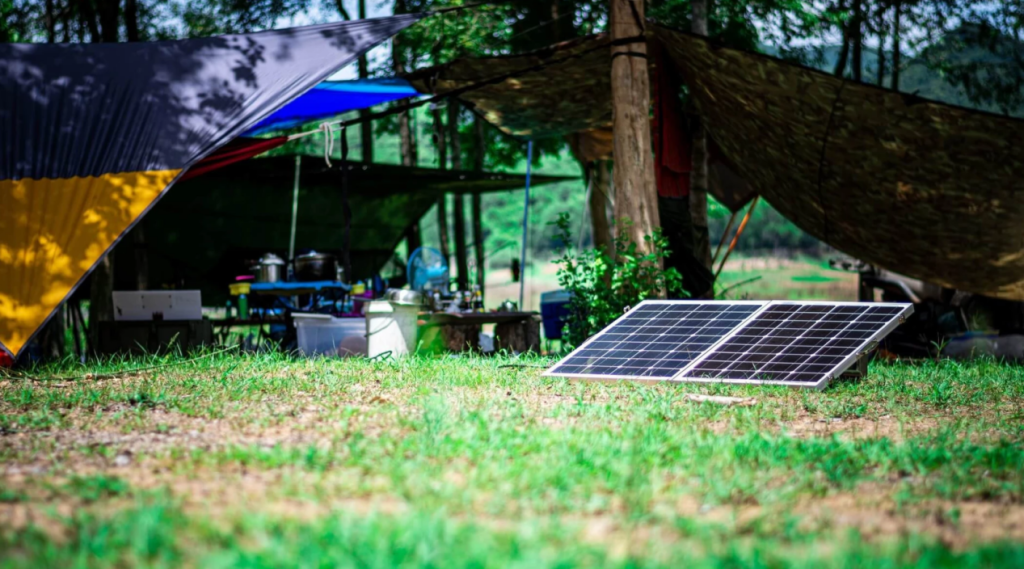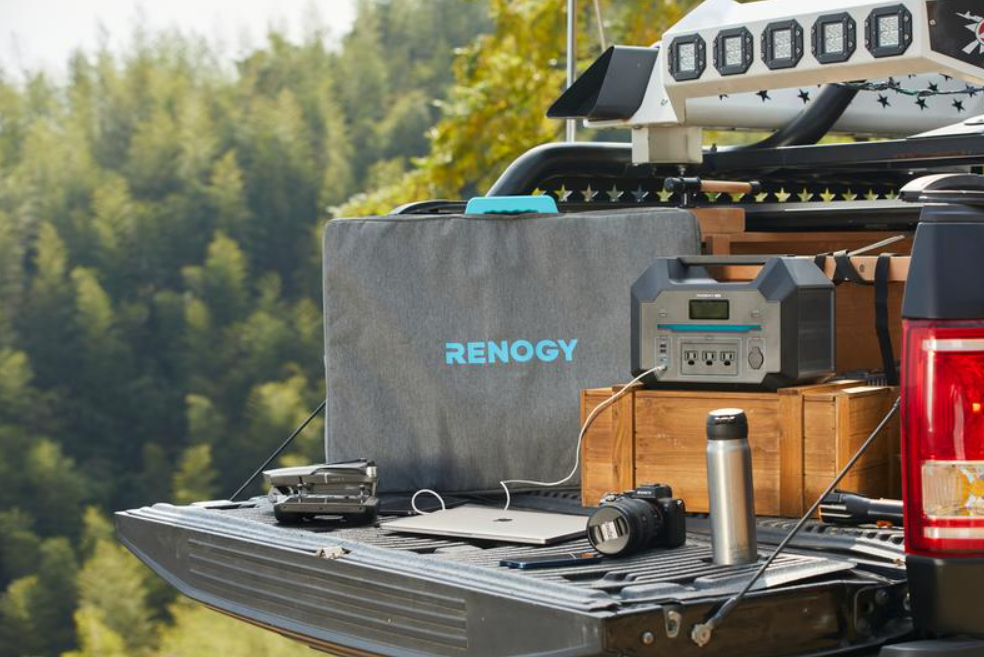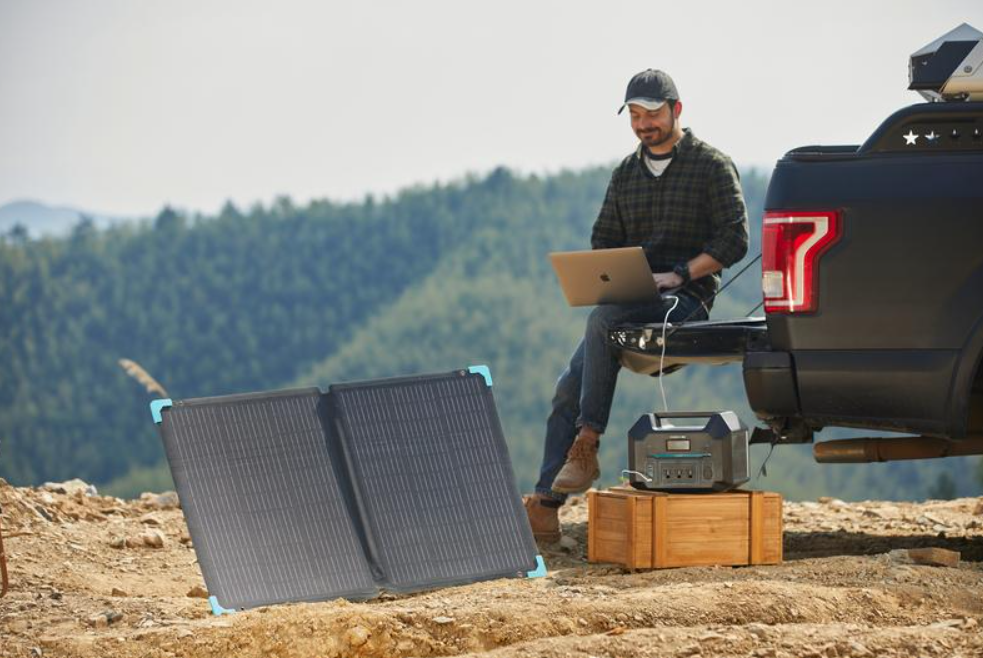Many small devices, from watches to pocket calculators, can be charged with solar energy. The power bank for the phone can also be charged by the sun. Solar generators are the right choice for devices requiring more power and performance. Combining a module and storage guarantees energy independence, even on the go.
Inexpensive energy anywhere: This promise can be fulfilled with photovoltaics, provided the sun is shining. Interest in solar power generation has increased significantly for some time, both for the energy supply at home and on the go. For mobile applications, so-called solar generators enjoy increasing popularity, for example, when camping.
What Are Solar Generators?
Solar generators are small PV systems with battery storage. Strictly speaking, these are island systems, as they have no connection to the public grid and therefore do not feed in any electricity. The solar power generated with simple, often flexible modules is fed into a handy, not-too-heavy battery (often referred to as a “power station”), which can be used for camping. Unlike mobile solar panels, which are used for low-power applications, solar generators power typical household appliances.
Occasionally only the battery is referred to as a solar powered generator and then spoken of solar generator with the solar panel when talking about the entire system. But that is misleading because the name “solar generator” says nothing else than that the energy is obtained (generated) from the sun (solar). Thus, the photovoltaic modules or solar panels are the actual solar generator, and the battery storage is only the “encore”. However, there is a good reason to focus on the batteries because they are technically much more complex and expensive than the often very constructed PV modules. Therefore, the occasionally used expression “power station” is more accurate because a power plant consists of turbines and the control and regulation technology as with the solar generator.
The modules
Most solar generators’ batteries are designed so that the solar modules can be connected with the standard plugs. In other words: The batteries can be charged with portable solar panels for camping. However, the modules intended for the roof are unsuitable for the purposes for which solar generators are usually used. Because “normal” solar modules are large (approx. 1.80 x 1 m) and heavy (20 to 25 kg), so nothing that you can easily carry around with you. While solar generators are primarily required for mobile use, standard modules are intended for permanent installation.
That is why the solar panels that go with the solar generators are usually smaller, lighter, and often flexible. With a view to mobile use, many providers have also designed the modules to be foldable so that they can be transported in a space-saving manner and are easy to carry. In addition, there are often tripods or elevations to align the modules as favorably as possible with the sun. Ideally, all the components of the small PV system are still packed in a bag so that everything is in order. Modules with outputs from 100 watts to 400 watts are available.

The battery storage
If you want to benefit from solar energy permanently on the road, you cannot rely solely on solar modules. You need a power storage unit to supply yourself with electricity even when the sun is not shining. With commercially available solar generators, this is a handy “power station” that supplies enough power for the smartphone and 12V and 220 consumers such as the cool box, laptops, coffee machines, or hotplates. Convenient means that the generators are mostly “boxes” with 15 to 30-cm side lengths. The weight varies from a few to over 20 kg. This means that one person can carry the device comfortably, but only very few will undertake longer hikes with a powerful battery.
Ideally, the batteries have the right connections for these devices, from the USB slot to the O-ring connection (as we know it from the electric cigarette lighter in the car) to the Euro or Schuko plug. Some devices also allow you to switch between 110 and 220 V. The solar generator battery must contain an inverter for the electricity required for standard household appliances to come from the socket. Like any stationary power storage device, the solar generator also has a battery management system that enables the battery to be charged and discharged efficiently and safely. Some of the devices also have an MPPT charge controller for PV-optimized charging.
When choosing a solar generator, the purpose for which it is to be used is decisive. The central question here is which capacity is required. Of course, the modules then have to match. Logically, a 12 volt battery with a high capacity also requires more powerful modules so that the memory can be charged in a reasonable time. To avoid problems, it makes sense to buy package solutions. If you buy the generator and solar modules separately, you should pay attention to which connections are on the battery. In an emergency, the plugs on the module can be changed, but this task should be reserved for a qualified electrician.
Of course, you can also charge the battery with mains power to have power available on the go. If this happens via the home PV system, there is no difference to the solar generator, except that the battery is fully faster if charged by 15 or 20 and not just by a solar panel. The whole thing is at least ecologically questionable if mains power is used because energy is lost during charging and discharging. If only the smartphone is to be supplied with electricity, a commercially available power bank is sufficient, which only has a fraction of the capacity of the solar generator battery.
Ideally, the batteries have the right connections for these devices, from the USB slot to the O-ring connection (as we know it from the electric cigarette lighter in the car) to the Euro or Schuko plug. Some devices also allow you to switch between 110 and 220 V. The solar generator battery must contain an inverter for the electricity required for standard household appliances to come from the socket. Like any stationary power storage device, the solar generator also has a battery management system that enables the battery to be charged and discharged efficiently and safely. Some of the devices also have an MPPT charge controller for PV-optimized charging.
When choosing a solar generator, the purpose for which it is to be used is decisive. The central question here is which capacity is required. Of course, the modules then have to match. Logically, a battery with a high capacity also requires more powerful modules so that the memory can be charged in a reasonable time. To avoid problems, it makes sense to buy package solutions. If you buy the generator and solar modules separately, you should pay attention to which connections are on the battery. In an emergency, the plugs on the module can be changed, but this task should be reserved for a qualified electrician.
Of course, you can also charge the battery with mains power to have power available on the go. If this happens via the home PV system, there is no difference to the solar generator, except that the battery is fully faster if charged by 15 or 20 and not just by a solar panel. The whole thing is at least ecologically questionable if mains power is used because energy is lost during charging and discharging. If only the smartphone is to be supplied with electricity, a commercially available power bank is sufficient, which only has a fraction of the capacity of the solar generator battery.
Increase the service life of the solar generator
The modules are usually robust but should be protected against the effects of violence. It is also not recommended to store heavy objects on the modules. Before connecting to the battery, check that the plugs and cables are not damaged.
The same applies to the accumulators of the solar generators as to all batteries: They do not like too much heat or excessive cold, and they do not like moisture. If you use a solar generator when camping in summer, you should ensure the generator is in the shade as much as possible. The device gets warm during operation, and direct sunlight can lead to overheating.
It is also not a good idea to leave the solar generator battery in front of the tent overnight so that the condensation collects on it in the morning. The generator is better placed in the (cool) car or protected in another way.
If the solar generator is not used for longer, it should be stored in a cool (but frost-free) and dry place with a charge level of 30 to 70%.

Are solar generators suitable as emergency power generators?
A typical household assumes a requirement of 3 to 5 kW. So far, diesel or petrol engines have primarily been used as emergency generators to generate electricity. The devices are often noisy and smell-intensive, especially with diesel. The idea of using solar generators for emergency power supply is therefore attractive. Conventional emergency power generators for households are available from 1 kW upwards, and the output is only limited by the willingness to spend money. Smaller solar generators can still keep up here in terms of price, and larger solar generators are relatively more expensive than conventional emergency power generators.
However, if only little energy is required, environmentally friendly devices are a good alternative, always provided that the sun is shining or the battery has been charged in time. Nothing stands in the way of an emergency power supply if this requirement is met – even if there is a decisive disadvantage. While you can top up diesel or petrol in the emergency generator when running low, charging the solar generator battery takes a while.
It would be most convenient if the electricity could be fed directly into the home network, but this is usually impossible without additional hardware. It is advisable to connect the required devices directly to the battery of the solar generator. It is important to think in advance about which household appliances must be supplied with electricity, how much power they require, and how long they should be operated. Questions to consider when buying the solar generator.
In the case of a battery (such as a 12v or 48v lithium ion battery), more capacity is always accompanied by an increase in size and weight. A power station is usually intended for mobile applications, so the capacity is comparatively low. An entire household cannot be supplied with it. Although there are solar generator batteries whose capacity can be increased by combining them, it is questionable whether this makes economic sense. In the event of a power outage in your home, battery storage such as that used with photovoltaic systems is the more sensible option. However, these solar storage tanks do not necessarily have an emergency power function, which must be purchased with the device. Independently of this, the solar generator can provide power for several important applications, such as communication technology to stay up to date or the refrigerator to keep food from spoiling.






























































